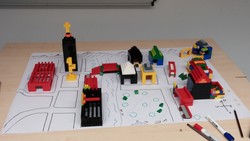LegoScrum in the context of the IT Project Management Tutorial

We constantly strive to improve our lectures and to make them even more interesting to our students. As Charles Darwin once said: "Only a fool makes no experiments." For this reason, we tried an experiment called LegoScrum in the course of the IT Project Management Tutorial this Winter term.
Scrum is a slim, agile process for project management and LegoScrum is a Scrum simulation implemented by means of Lego bricks. Students who participated in the tutorial were meant to implement the project Value City.
As a first step, the participants were equally divided into two groups. Although both teams were meant to work on their own, they were no competitors but worked for the same vendor. The trainer was the ProductOwner. Furthermore, in one of the tutorials, there was a ScrumMaster who was responsible for the observance of the processes and rules.
After the division of the developer teams, the project was announced and the different UserStories of the product backlog were presented. Subsequently, the Scrum process was explained so that the participants could observe it. To release the project, the teams had to manage four sprints altogether. In the course of each sprint, the participants had to observe the following time designations:
· Three minutes for the planning of the sprint,
· Seven minutes for the sprint,
· and five minutes for the sprint review.
In the context of the four sprints, different subproducts had to be created. The Product Backlog consisted of different User Stories such as one- and two-storey houses, a school, a town hall, the famous "Henry L. Gantt"-moument and many other customer requirements.
In the course of the seven-minute sprint, the participants eagerly constructed and puzzled over their work. After the first sprint, most groups showed a touch of satisfaction since most of them thought that the project was very easy. But far from it!
In the course of the first sprint review, most students came to realize that the inquiry of requirements during the planning phase is a crucial part of the first sprint phase. Thus, some User Stories had to to return to the Product Backlog.
Just like in real life, after each sprint, the Release Burndown Chart was updated and the groups were told how much time they had left until the release of the project and how many User Stories they had left to process.
Bit by bit, the groups handed in their subproducts until the final product Value City was completed (see figure).
We hope that the students had fun and learned from the simulation. The trainers definitely learned from the project - namely that Lego is a great means for making methods of project management understandable.



